#Albert Pinson
Explore tagged Tumblr posts
Text
De onbeantwoorde liefde van Adèle Hugo
Ze was een dochter van de vermoedelijk beroemdste man ter wereld. En ze was doodongelukkig. Adèle Hugo (1830-1915) ontmoette in 1854 de Britse officier Albert Pinson, op wie zij hopeloos verliefd raakte. Pinsons houding tegenover haar bleef onduidelijk. Toen hij in 1861 werd overgeplaatst naar Halifax in Canada, reisde Adèle hem ongevraagd achterna. Het was een geval van wat je nu ‘stalken’ zou…

View On WordPress
#Adèle H.#Adèle Hugo#Adjani#Albert Pinson#Céline Baa#Frances Guille#Guernesey#Jersey#Juliette Drouot#Kanaaleilanden#Léopoldine#Le Figaro#Mark Bostridge#Napoleon III#Panthéon#Richard Dubugnon#sainte-Beuve#seance#Truffaut#Victor Hugo
0 notes
Text
“EL SILENCIO MÁS LARGO DE LA HISTORIA POR AMOR”
Un día lluvioso del año 1850 la policía se encontró a una mujer andrajosa y desorientada por las calles de New York. La chica les habló en una lengua extranjera que ellos no pudieron entender.
Fue llevada a un hospital donde le diagnosticaron amnesia. Y fue identificada como Adele Hugo, hija del famoso escritor Víctor Hugo, autor de "Los Miserables".
La historia de la mujer no sólo rompió el corazón de su padre sino del mundo entero. Al saber que Adele se enamoró de un militar ingles llamado Albert Pinson, el cual la rechazó.
Él viajó y ella lo siguió hasta Nueva Escocia, donde el hombre vivió por años manipulando y quitándole el dinero a Adele, hasta que finalmente la abandonó sin dinero, sin amigos y destrozada en la ciudad de New York.
Adele fue devuelta a Francia pero estaba aniquilada en todos los aspectos, se sentía humillada y juró no volver a hablar nunca más.
Su padre Víctor Hugo trató por un espacio de 35 años de inducirla a que rompiera ese juramento. Pero sus esfuerzos fueron en vano.
Por un espacio de 65 años, desde 1850 hasta su muerte en 1915 Adele "la miserable" nunca volvió a hablar ni pronunció palabra alguna.

Se considera el silencio auto impuesto más largo de la historia.
14 notes
·
View notes
Text

“EL SILENCIO MÁS LARGO DE LA HISTORIA POR AMOR”
Un día lluvioso del año 1850 la policía se encontró a una mujer andrajosa y desorientada por las calles de New
York. La chica les habló en una lengua extranjera que ellos no pudieron entender.
Fue llevada a un hospital donde le diagnosticaron amnesia.
Y fue identificada como Adele Hugo, hija del famoso escritor Víctor Hugo, autor de "Los Miserables".
La historia de la mujer no sólo rompió el corazón de su padre sino del mundo entero. Al saber que Adele se enamoró de un militar ingles llamado Albert Pinson, el cual la rechazó.
Él viajó y ella lo siguió hasta Nueva Escocia, donde el hombre vivió por años manipulando y quitándole el dinero a Adele, hasta que finalmente la abandonó sin dinero, sin amigos y destrozada en la ciudad de New York.
Adele fue devuelta a Francia pero estaba aniquilada en todos los aspectos, se sentía humillada y juró no volver a hablar nunca más.
Su padre Víctor Hugo trató por un espacio de 35 años de inducirla a que rompiera ese juramento. Pero sus esfuerzos fueron en vano.
Por un espacio de 65 años, desde 1850 hasta su muerte en 1915 Adele "la miserable" nunca volvió a hablar ni pronunció palabra alguna.
Se considera el silencio auto impuesto más largo de la historia.
11 notes
·
View notes
Text
[COUPS DE ROULIS]
Musique André Messager
Livret Albert Willemetz
Adapté du roman éponyme de Maurice Larrouy
Direction musicale Alexandra Cravero
Mise en scène Sol Espeche
Cheffe de choeur et de chant Delphine Dussaux
Collaboratrice artistique Pauline Jambet
Scénographie Oria Puppo
Chorégraphie Aurélie Mouilhade
Costumes Sabine Schlemmer
Maquillage et perruques Maurine Baldassari
Lumières Loris Gemignani
Vidéo Alexis Lardilleux
Conseiller artistique Christophe Mirambeau
Avec
Puy Pradal Jean-Baptiste Dumora
Béatrice Clarisse Dalles
Kermao Christophe Gay
Gerville Philippe Brocard
Sola Myrrhis Irina De Baghy
Pinson Guillaume Beaudoin
Haubourdin Mathieu Septier
Muriac Célian d'Auvigny
Bellory - L’Amiral Maxime Le Gall
Subervielle Matthias Deau
Mylène Bourbeau, Lucile Komitès, Hortense Venot, Laure Ilef, Marion L'Héritier et Claire Naessens
Réservations en points de vente habituels
📍Théâtre Impérial - Opéra de Compiègne- 3 mars 2023
📍Atelier Lyrique de Tourcoing - 5 mars 2023
📍Athénée Théâtre Louis-Jouvet du 10 au 19 mars 2023
🎥 Alexis Lardilleux
Production Les Frivolités Parisiennes
Co-Production Théâtre Impérial - Opéra de Compiègne et Athénée Théâtre Louis-Jouvet
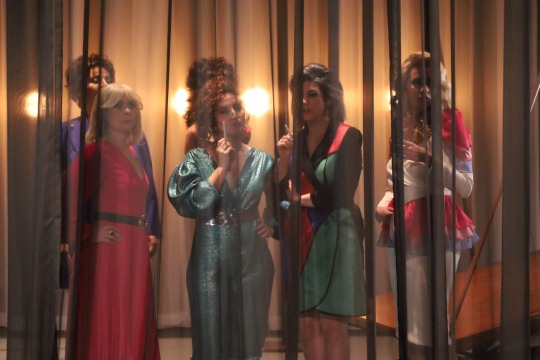
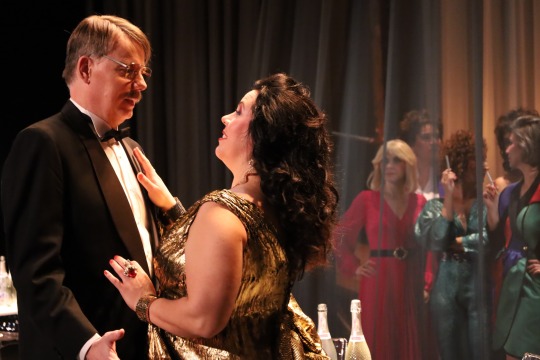
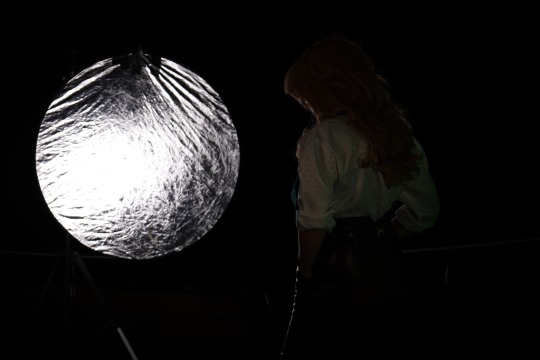
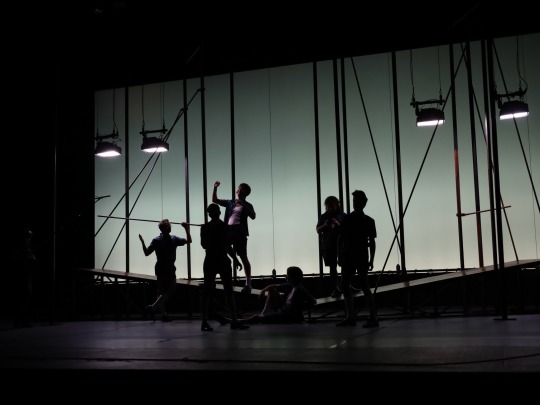
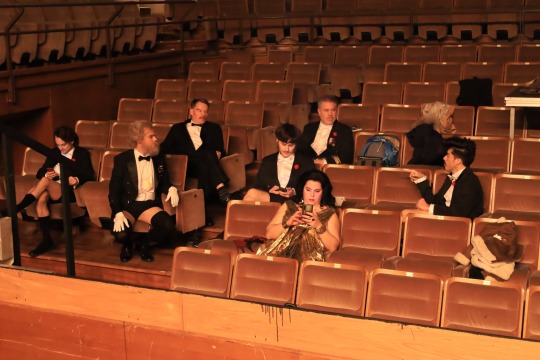
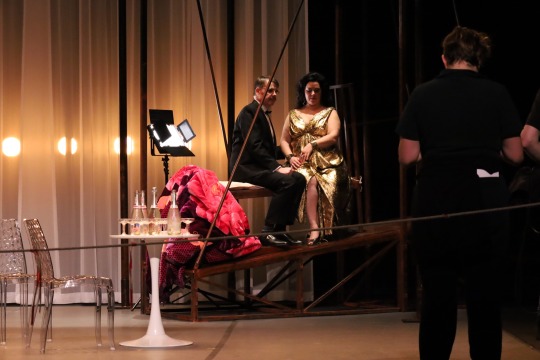
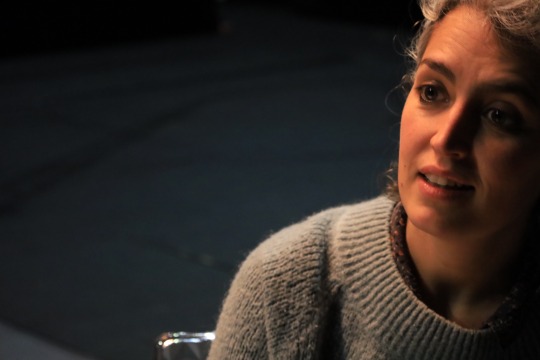
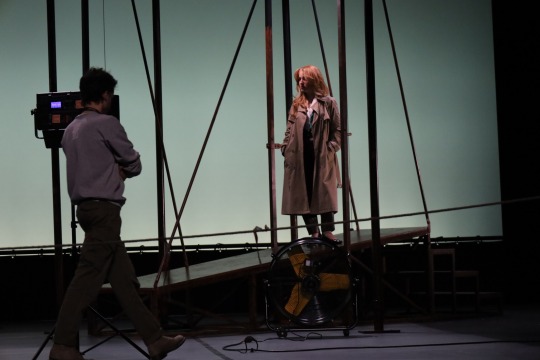
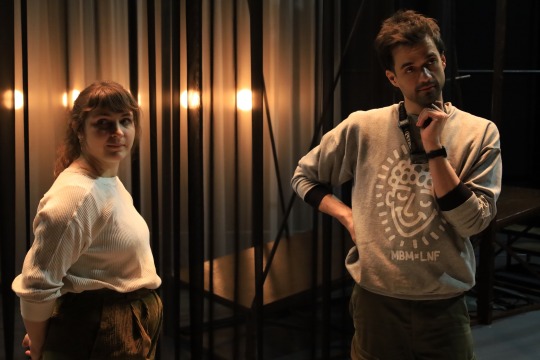

0 notes
Text
Lettre d’Adèle Hugo au Lieutenant Albert Pinson- sur canevas de La nuit je mens de Bashung
On m’a vu sur les chemins
Vagabonde, j’errais
Insolente
Débordante
J’ai fait la folle pour fuir la vie
J’ai fait le vide
J’ai fait le mur. T’étais pas né
A la peur, j’ai dit tchao
Tu t’es pas inquiété
J’étais loin de là soudain
Pour un peu, je reviens. Histoire d’eau
La nuit je mens
Je veux juste m’évader pour un temps
La nuit je mens
Je m’en remets au vent
J’ai dans les bottes
Des envies d’au-delà
Où subsistent encore ton parfum
J’ai fait la belle
Dans cette nuit étoilée
Tes envies
Je les faisais miennes
Te voilà parti, seulement, t’es toujours en moi
De partir en douce
J’ai fait un délire
Des kilomètres de toi, je mets
Un jour à bout
Et un autre à entendre ta voix
A sentir tes pas
Revenir à moi, à nous
La nuit je mens
Je ne vis plus en ton absence
La nuit je mens
Je t’attends pour rien
J’ai dans les bottes
Des douleurs et des remords
Où subsiste encore ton écho
On m’a vu nue et sans vie
Je vais par delà les villes
Je cours je tombe
Sans savoir où aller
J’ai fait la folle pour fuir la vie
J’ai fait le vide
J’ai fait le mur. T’étais pas né
La nuit je mens
Je crois t’oublier
J’ai dans les bottes
Des pensées
Où subsistent encore ton regard.

adèle Hugo

L’histoire d’Adèle H- 1975- Truffaut -Adjani
20 notes
·
View notes
Text
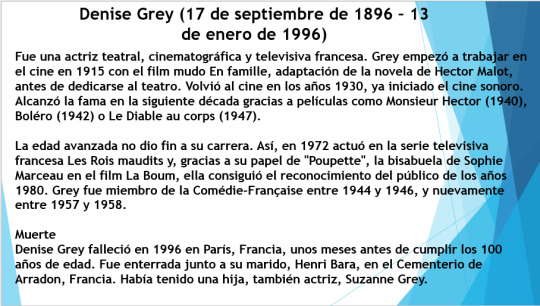
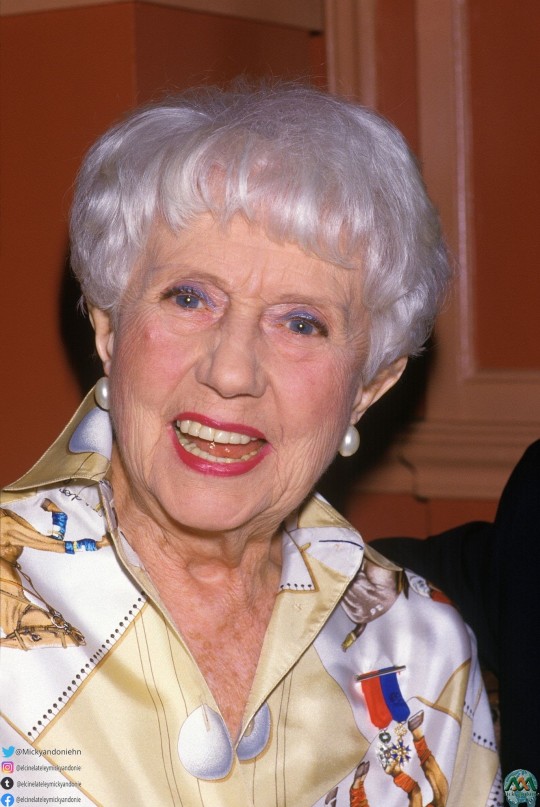
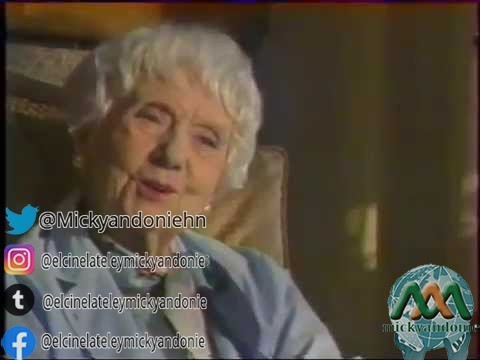
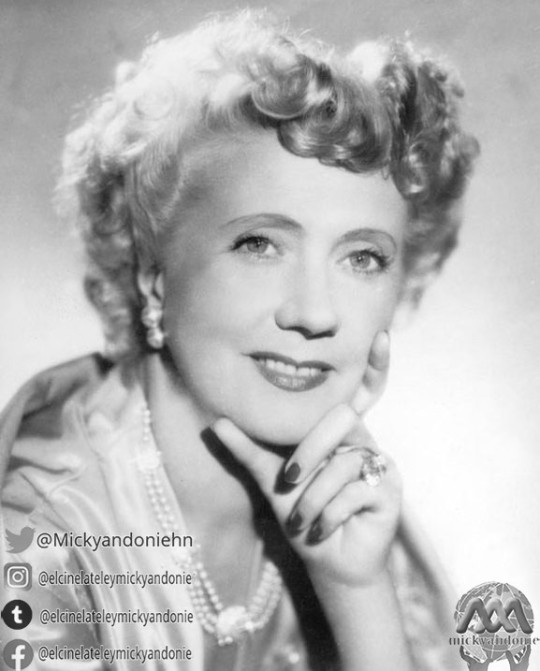
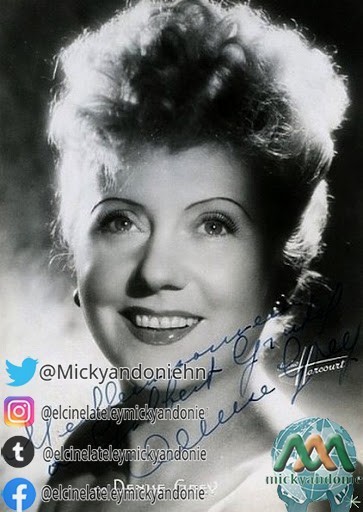

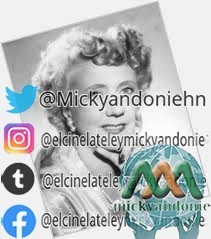
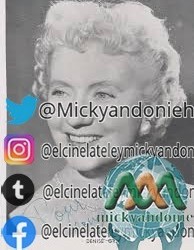

Denise Grey.
Filmografía
Cine
1913 : Mademoiselle Etchiko
1914 : En famille, de Georges Monca
1914 : Madame Rigadin, modiste, de Georges Monca
1914 : Mademoiselle Etchiko, de André Hugon
1914 : Le Voyage de Corbillon, de Georges Monca
1916 : Document secret, de René Navarre
1916 : Nemrod et Cie, de Maurice Mariaud
1916 : Rigadin professeur de danse, de Georges Monca
1917 : Les Bleus de l'amour, de Henri Desfontaines
1917 : Honneur d'artiste, de Jean Kemm
1935 : Jeunes Filles à marier, de Jean Vallée
1936 : La Dame de Vittel, de Roger Goupillières
1937 : Trois artilleurs au pensionnat, de René Pujol
1938 : Trois artilleurs à l'opéra, de André Chotin
1938 : Serge Panine, de Paul Schiller y Charles Méré
1940 : Monsieur Hector, de Maurice Cammage
1941 : Boléro, de Jean Boyer
1941 : Montmartre-sur-Seine, de Georges Lacombe
1942 : Romance à trois, de Roger Richebé
1942 : Le Voile bleu, de Jean Stelli
1942 : Des jeunes filles dans la nuit, de René Le Hénaff
1942 : Retour de flamme, de Henri Fescourt
1942 : L'Honorable Catherine, de Marcel L'Herbier
1943 : Adieu Léonard, de Pierre Prévert
1943 : Vingt-cinq ans de bonheur, de René Jayet
1943 : L'aventure est au coin de la rue, de Jacques Daniel-Norman
1944 : Les Caves du Majestic, de Richard Pottier
1945 : On demande un ménage, de Maurice Cam
1945 : Madame et son flirt de Jean de Marguenat
1945 : L'Insaisissable Frédéric, de Richard Pottier
1945 : L'Extravagante Mission, de Henri Calef
1946 : Étrange Destin, de Louis Cuny
1946 : Le Couple idéal, de Bernard Roland y Raymond Rouleau
1946 : Six heures à perdre, de Alex Joffé y Jean Lévitte
1946 : Coïncidences, de Serge Debecque
1946 : Le Diable au corps, de Claude Autant-Lara
1947 : Et dix de der, de Robert Hennion
1947 : Carré de valets, de André Berthomieu
1948 : Une femme par jour, de Jean Boyer
1948 : Bonheur en location, de Jean Wall
1949 : La Ronde des heures, de Alexandre Ryder
1949 : Tête blonde, de Maurice Cam
1949 : Mon ami Sainfoin, de Marc-Gilbert Sauvajon
1949 : Pas de week-end pour notre amour, de Pierre Montazel
1950 : Rome-Express, de Christian Stengel
1950 : Les Petites Cardinal, de Gilles Grangier
1950 : Demain nous divorçons, de Louis Cuny
1952 : Allô... je t'aime.
1952 : La Tournée des grands ducs, de André Pellenc
1953 : Art. 519 Codice Penale, de Leonardo Cortese
1953 : Il Seduttore, de Franco Rossi
1953 : Raspoutine, de Georges Combret
1953 : Dortoir des grandes, de Henri Decoin
1953 : Les Corsaires du bois de Boulogne, de Norbert Carbonnaux
1953 : Julietta, de Marc Allégret
1953 : Le Père de Mademoiselle, de Marcel L'Herbier
1954 : Escalier de service, de Carlo Rim, sketch Les Béchard
1954 : Le Printemps, l'automne et l'amour, de Gilles Grangier
1954 : Fantaisie d'un jour, de Pierre Cardinal
1954 : Le Mouton à cinq pattes, de Henri Verneuil
1954 : Poisson d'avril, de Gilles Grangier
1955 : La Villa Sans-Souci, de Maurice Labro
1955 : La Rue des bouches peintes, de Robert Vernay
1956 : Sylviane de mes nuits, de Marcel Blistène
1956 : L'Auberge fleurie, de Pierre Chevalier
1956 : Une nuit aux Baléares, de Paul Mesnier
1956 : Mitsou, de Jacqueline Audry
1957 : À pied, à cheval et en voiture, de Maurice Delbez
1957 : Carve Her Name with Pride, de Lewis Gilbert
1957 : La Peau de l'ours, de Claude Boissol
1957 : Le Tombeur, de René Delacroix
1957 : Police judiciaire, de Maurice de Canonge
1957 : Mimi Pinson, de Robert Darène
1957 : C'est la faute d'Adam, de Jacqueline Audry
1958 : À pied, à cheval et en spoutnik, de Jean Dréville
1959 : Bomben im Monte-Carlo, de Georg Jacoby
1959 : Le Confident de ces dames, de Jean Boyer
1960 : Le Panier à crabes, de Joseph Lisbona
1960 : La Française et l'Amour, de Christian-Jaque, sketch Le Divorce
1963 : La Bonne Soupe, de Robert Thomas
1965 : Pas de caviar pour tante Olga, de Jean Becker
1969 : La Maison de campagne, de Jean Girault
1970 : Hello-Goodbye, de Jean Negulesco
1970 : Los Aristogatos, de The Walt Disney Company
1971 : Mais qui donc m'a fait ce bébé ?, de Michel Gérard
1980 : La Boum, de Claude Pinoteau
1982 : La Boum 2, de Claude Pinoteau
1982 : N'oublie pas ton père au vestiaire..., de Richard Balducci
1982 : En cas de guerre mondiale, je file à l'étranger, de Jacques Ardouin
1983 : Le Voleur de feuilles, de Pierre Trabaud
1985 : Le Gaffeur, de Serge Pénard
1988 : Les Saisons du plaisir, de Jean-Pierre Mocky
1991 : Tchin tchin, de Gene Saks.
Televisión
1960 : Rouge, de André Leroux
1962 : Chéri
1967 : Le Chevalier Tempête, de Yannick Andréi
1969 : Tout pour le mieux
1971 : Une autre vie
1972 : Les Rois maudits, de Marcel Jullian y Claude Barma
1977 y 1982 : Cinéma 16
1978 : Un ours pas comme les autres
1979 : Les Moyens du bord
1979 : Les Dames de la côte, de Nina Companeez
1980 : L'Esprit de famille
1983 : Merci Sylvestre
1985 : Les temps difficiles.
Teatro
1916 : Six Hommes, une femme et un singe, de Pierre Veber y Yves Mirande, Théâtre Michel
1921 : Comédienne, de Jacques Bousquet y Paul Armont, Théâtre des Nouveautés
1922 : La Femme de mon ami, Théâtre de l'Athénée
1922 : Atout... Cœur !, de Félix Gandéra, Théâtre de l'Athénée
1924 : Si je voulais..., de Paul Géraldy y Robert Spitzer, Théâtre du Gymnase Marie-Bell
1926 : Passionnément, de Maurice Hennequin y Albert Willemetz, Théâtre de la Michodière
1936 : Europe, de Maurice Rostand, Théâtre Pigalle
1938 : Le Valet maître, de Paul Armont y Léopold Marchand, escenografía de Pierre Fresnay, Théâtre de la Michodière
1948 : Les Enfants d'Edouard, de Frederic Jackson y Roland Bottomley, adaptación de Marc-Gilbert Sauvajon, escenografía de Jean Wall, Théâtre Édouard VII
1949 : Les Enfants d'Edouard, de Frederic Jackson y Roland Bottomley, adaptación de Marc-Gilbert Sauvajon, escenografía de Jean Wall, Théâtre des Célestins
1950 : George et Margaret, de Marc-Gilbert Sauvajon y Jean Wall, escenografía de Jean Wall, Théâtre Daunou
1950 : Il faut marier maman, de Marc-Cab y Serge Veber, escenografía de Pierre Dux, Théâtre de Paris
1953 : Faites-moi confiance, de Michel Duran, escenografía de Jean Meyer, Théâtre du Gymnase Marie-Bell
1955 : Les Enfants d'Edouard, de Frederic Jackson y Roland Bottomley, adaptación de Marc-Gilbert Sauvajon, escenografía de Jean Wall, Théâtre des Célestins
1956 : La Femme du siècle, de Claude Schnerb, escenografía de Jacques-Henri Duval, Théâtre des Célestins, giras Georges Herbert
1959 : Bon Week-End Mr. Bennett, de Paule de Beaumont a partir de Arthur Watkyn, escenografía de Michel Vitold, Théâtre de la Gaîté-Montparnasse
1961 : Ocho mujeres, de Robert Thomas escenografía de Jean Le Poulai.
1962 : Ocho mujeres, de Robert Thomas, escenografía de Jean Le Poulain, Théâtre des Bouffes-Parisiens
1963 : Vénus de Milo, de Jacques Deval, escenografía de Pierre Mondy, Théâtre des Célestins
1965 : Assassins associés, de Robert Thomas, escenografía de Jean Piat, Théâtre Antoine y Théâtre du Palais-Royal
1966 : J'y suis, j'y reste, de Jean Valmy y Raymond Vincy, escenografía de Jean Valmy, Théâtre Marigny
1966 : La Fin du monde, de Sacha Guitry, escenografía de Jean-Pierre Delage, Théâtre de la Madeleine
1967 : Quarante Carats, de Pierre Barillet y Jean-Pierre Gredy, escenografía de Jacques Charon, Théâtre de la Madeleine
1971 : Le Train de l'aube, de Tennessee Williams, escenografía de Jean-Pierre Laruy, Théâtre Édouard VII
1972 : En avant... toute !, de Michel André, escenografía de Michel Roux, Théâtre Édouard VII
1972 : La Bonne Adresse, de Marc Camoletti, escenografía de Christian-Gérard, Théâtre Michel
1973 : La Royale Performance, de Marcel Mithois, escenografía de Jean-Pierre Delage, Théâtre des Bouffes-Parisiens
1974 : Le Tube, de Françoise Dorin, escenografía de François Périer, Théâtre Antoine
1976 : Le Jardin de craie, de Enid Bagnold, escenografía de Raymond Gérôme, Théâtre Hébertot
1977 : Bichon, de Jean de Létraz, escenografía de Jacques Valois, Théâtre de Charleville-Mézières
1978 : Crime à la clef, de Alain Bernier y Roger Maridat, escenografía de Jean-Paul Cisife, Théâtre Tristan-Bernard
1981 : La vie est trop courte, de André Roussin, escenografía de Michel Fagadau, Théâtre Daunou
1983 : La vie est trop courte, de André Roussin, escenografía de Michel Fagadau, Théâtre de la Gaîté-Montparnasse
1984-1985 : Les Temps difficiles, de Édouard Bourdet, escenografía de Pierre Dux, Théâtre des Variétés
1985 : Harold et Maude, de Colin Higgins, escenografía de Jean-Luc Tardieu, Espace 44 Nantes
1987 : Harold et Maude, de Colin Higgins, escenografía de Jean-Luc Tardieu, Théâtre Antoine
1989 : Arsénico y encaje antiguo, de Joseph Kesselring, escenografía de Jean-Luc Tardieu, gira
1991 : La sopera, de Robert Lamoureux, escenografía de François Joffo.
Operetas
1919 : Nelly, de Marcel Lattès, con Félix Oudart (Théâtre de la Gaîté)
1950 : Il faut marier maman, de Guy Lafarge, Théâtre de Paris, con Roland Armontel.
Créditos: Tomado de Wikipedia
https://es.wikipedia.org/wiki/Denise_Grey
#HONDURASQUEDATEENCASA
#ELCINELATELEYMICKYANDONIE
5 notes
·
View notes
Text
Adel sindromu
Böyük fransız yazıçısı Viktor Hüqonun qızı madmazel Adelin uğursuz eşq macərası - "Adel sindromu"
Məşhur yazıçının gənc qızı zabit Albert Pinsona aşiq olmuşdu, Pinson isə madmazelin məhəbbətinə qarşı biganə idi. Nə Adelin gözəlliyi, nə də yazıçının şan-şöhrəti zabitin ürəyini yumşalda bilmədi. Qarşılıqsız məhəbbət qızın ürəyini, beynini gəmirirdi, qız öz sevgisi uğrunda dünyadan vaz keçməyə belə hazır oduğunu gizlətmirdi. İngilis ordusunun leytenantı Albert Pinson xidməti vəzifəsiylə əlaqədar Kanadaya köçməli oldu. Fədakar Adel ailəsindən xəbərsiz leytenantın peşinə düşüb uzaq Kanadaya getdi, leytenantın yaşadığı yerə yaxın bir mənzil kirayələdi, bir neçə il burda yaşadı, ingilis zabiti yenə onu görməməzlikdən gəldi, zabit üçün dünyada Adel adlı bir insan yox idi, Adel isə hər fürsətdə Albert Pinsonun məşuqəsi olduğunu söyləyirdi. Adel Albertdən hamilə qaldığını, doğuş zamanı körpəsini itirdiyini ürək ağrısı ilə yeni qonşularına danışanda özünü ələ ala bilmirdi, hıçqırıqdan boğazı tutulurdu. Maraqlıdır, görəsən, madmazel Adel uydurduğu yalanlara inanırdımı? Ağlı başında, özünə hörmət hissini itirməmiş qürurlu bir xanım yəqin ki, xəyallar dünyasında yaşayırmış və irreal dünya onun üçün elə gerçək dünyadan başqa bir şey deyilmiş.Bədbəxt qız Kanadadan yazdığı məktublarında Albertə ərə getdiyini və bu evlilikdə xoşbəxt olduğunu bildirirdi. Albert Pinson isə Adelin oyunlarından bezmişdi.Albert Pinson başqa bir qadını sevirdi, onlar tezliklə evlənəcəkdilər, Adel vəkilinin hiyləgərliyi sayəsində işi elə qurdu ki, zabitin nikahı baş tutmadı. Sonralar yenə Pinsonun xidməti yerini dəyişdirdilər və Adel yenə zabitin peşini buraxmadı. Madmazel Hüqo reallıq hissini itirmişdi, vaxtı ilə Paris gözəli kimi tanınan xanım üstünə-başına, yeməyinə-içməyinə fikir vermirdi, daim stress vəziyyətində olurdu, özünü-sözünü bilmirdi. Və əlbəttə ki, tez-tez xəstələnirdi. İş o yerə çatmışdı ki, Adel dərdindən dəli olduğu kişinin yanına yüngül əxlaqlı qadınlar gətirirdi, qumarda əli gətirməyən zabitin borclarını ödəyirdi..Viktor Hüqonun xahişi ilə Adeli tapıb Parisə gətirdilər. Dünya şöhrətli yazıçının qarşılıqsız məhəbbətdən ağlını itirmiş zavallı qızı Adel ömrünün qalan hissəsini ruhi xəstəxanada yaşadı, orda da qocalıb öldü...
65 notes
·
View notes
Photo



L'Histoire d'Adèle H. (1975) dir. François Truffaut, cinematography Néstor Almendros
Adèle Hugo (daughter of Victor Hugo) was schizophrenic and her obsession with Albert Pinson is believed to have been the result of erotomania symptomatic of her mental illness. Much of her struggles and inner life are documented in her correspondences and journals, which she kept until her mental state was too bad for her to keep it up.
Truffaut absolutely mishandled Adèle’s illness in his film, but in true Adjani fashion, despite the writing and direction not really allowing for a sensitive portrayal, the actress understands her character thoroughly - and this is what translates on screen.
#l'histoire d'adèle h#the story of adele h#isabelle adjani#bruce robinson#Francois Truffaut#nestor almendros#film#cinematography
23 notes
·
View notes
Text
Reading through 2017
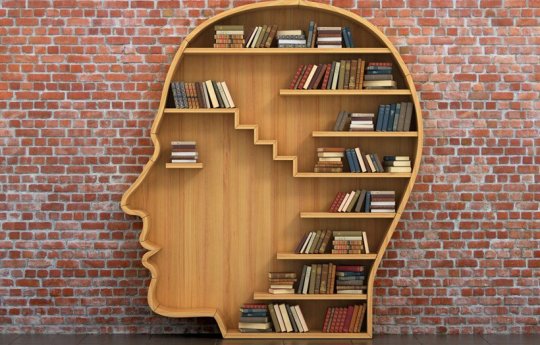
What I’ve read (and am reading) so far in 2017…
1. The United States of Soccer: MLS and the Rise of American Soccer Fandom Phil West
2. The North Water: A Novel Ian McGuire
3. The Cradle, the Cross, and the Crown: An Introduction to the New Testament Andreas J. Köstenberger, L. Scott Kellum, Charles L Quarles
4. The Power of the Other: The startling effect other people have on you, from the boardroom to the bedroom and beyond-and what to do about it Henry Cloud
5. The Worship Pastor: A Call to Ministry for Worship Leaders and Teams Zac M. Hicks
6. Faithful: A Theology of Sex (Ordinary Theology) Beth Felker Jones
7. Psalm 116: A 30-day Devotional on Rescue, Redemption and the Life We Live in Response Kyle Burkholder
8. Celine: A novel Peter Heller
9. Dark Matter: A Novel Blake Crouch
10. Four Views on Eternal Security (Counterpoints: Bible and Theology) J. Matthew Pinson, Michael S. Horton, Norman L. Geisler, Stephen M. Ashby, J. Steven Harper
11. The Sovereignty of God Arthur W. Pink
12. Divine Foreknowledge: Four Views (Spectrum Multiview Book Series) James K. Beilby, Paul R. Eddy, Gregory A. Boyd, David Hunt, William Lane Craig, Paul Helm
13. Final Destiny: The Future Reign of The Servant Kings Revised Edition Joseph C. Dillow
14. The Pastor: A Memoir Eugene H. Peterson
15. Free Grace Soteriology: Revised Edition David R. Anderson
16. Predestination & Free Will: Four Views of Divine Sovereignty and Human Freedom (Spectrum Multiview Book Series) David Basinger, Randall Basinger, John Feinberg, Norman Geisler, Bruce Reichenbach, Clark H. Pinnock
17. The Hyper-Grace Gospel: A Response to Michael Brown and Those Opposed to the Modern Grace Message Paul Ellis
18. The Faith That Saves: The Nature of Faith in the New TestamentAn Exegetical and Theological Analysis on the Nature of New Testament Faith Chay, Fred
19. Nineveh: A Novel Henrietta Rose-Innes
20. Five Views on Biblical Inerrancy (Counterpoints: Bible and Theology) Zondervan, J. Merrick, Stephen M. Garrett, Stanley N. Gundry, Jr., R. Albert Mohler, Peter E. Enns, Michael F. Bird, Kevin J. Vanhoozer, John R. Franke
21. Faith Works: The Gospel According to the Apostles MacArthur, John F.
22. Jonah: A 30-day Devotional on Running, Rescue, and the Incredible Depth of God's Love Burkholder, Kyle
23. Gospel Fluency: Speaking the Truths of Jesus into the Everyday Stuff of Life Jeff Vanderstelt, Jackie Hill Perry
24. 12 Ways Your Phone Is Changing You Tony Reinke, John Piper
25. Everybody Lies: Big Data, New Data, and What the Internet Can Tell Us About Who We Really Are Seth Stephens-Davidowitz
26. Liturgy of the Ordinary: Sacred Practices in Everyday Life Tish Harrison Warren, Andy Crouch
27. The Death and Life of the Great Lakes Dan Egan
28. The Unstuck Church: Equipping Churches to Experience Sustained Health Tony Morgan
29. The Association of Small Bombs: A Novel Karan Mahajan
30. Christian Theology Erickson, Millard J.
31. StandOut 2.0: Assess Your Strengths, Find Your Edge, Win at Work Buckingham, Marcus
32. Experiencing Grief Wright, H. Norman
33. How Emotions Are Made: The Secret Life of the Brain Lisa Feldman Barrett
34. Behave: The Biology of Humans at Our Best and Worst Robert M. Sapolsky
6 notes
·
View notes
Photo

365 Day Movie Challenge (2017) - #63: The Story of Adèle H. (1975) - dir. François Truffaut
It is never any surprise when directors hire actress Isabelle Adjani, who has an incredible ability to mine a character for the most intense depths of emotion. This was probably never more evident than in her tortured work in Andrzej Zulawski’s grotesquely creative horror film Possession (1981), but Truffaut’s The Story of Adèle H. gives Zulawski a run for his money as far as depicting a woman’s slowly fracturing psyche and body.
Set in 1863-1864, Story has Adjani playing Adèle Hugo, second daughter of world-famous author and political figure Victor Hugo, a woman whose schizophrenia and erotomania begin to manifest when she fanatically falls in love with a handsome British army lieutenant, Albert Pinson (Bruce Robinson, later of Withnail and I directing fame) and follows him from England to his regiment’s new station in Halifax, Nova Scotia. Pinson is indifferent to Adèle, with whom he had had a brief affair when he lived near their family on the isle of Guernsey (the Hugos lived in exile, having been forced out of France for dissidence), but Adèle’s certainty that Pinson intends – present tense – to marry her gradually erodes her sense of reason, exacerbates the mental illness she didn’t understand that she had and drives her out of her mind. Twenty-year-old Isabelle Adjani received an Academy Award nomination for this performance, an absolutely deserved recognition that solidified her reputation as one of French cinema’s most exciting stars and got her work with such varied filmmakers as Roman Polanski, André Téchiné, Walter Hill, Werner Herzog, James Ivory, the aforementioned Zulawski, Claude Miller, Luc Besson, Elaine May and Bruno Nuytten (with whom Adjani received her second Best Actress Oscar nomination for Camille Claudel).
I have noticed recently that I have been gravitating towards stories of obsession, passion and violence: The Crying Game (1992), The Naked Kiss (1964), Angel (1982), Felicia’s Journey (1999), Asphalt (1929), Unfaithful (2002), Mona Lisa (1986), Exotica (1994). Of course, the ultimate icons of this mixed genre are numerous Hitchcock thrillers including Spellbound (1945), Vertigo (1958) and Marnie (1964), as well as Brian De Palma’s many Hitchcockian films, like Sisters (1973), Dressed to Kill (1980) and Body Double (1984). The Story of Adèle H. does not contain the same level of excitement as those other, more suspenseful films, though, since Story is a biopic and a period-piece drama rather than a thriller.
The film is consistently watchable since Néstor Almendros supplies good cinematography (especially in close-ups of the two leads) and, as mentioned, Adjani is brilliant (thankfully since she is the center of the film), but it is unfortunate that Truffaut could not elicit better performances from most of the supporting actors. There are a few sympathetic portrayals by Sylvia Marriott (Adèle’s landlady at a Halifax boarding house), Joseph Blatchley (a bookshop proprietor who is clearly sweet on Adèle) and Ivry Gitlis (best known to the world as a stellar violinist; here, he plays a hypnotist sought by Adèle in hopes of literally casting a spell on Lt. Pinson), but Truffaut’s film does not quite reach the heights of mastery.
#365 day movie challenge 2017#l'histoire d'adèle h.#the story of adèle h.#the story of adele h.#the story of adele h#1975#1970s#70s#françois truffaut#francois truffaut#truffaut#isabelle adjani#bruce robinson#sylvia marriott#joseph blatchley#ivry gitlis#néstor almendros#nestor almendros#adèle hugo#adele hugo#victor hugo#french cinema#french film#french films#french movies#world cinema#foreign cinema#foreign film#foreign films#foreign movies
6 notes
·
View notes
Text
Okay. Let’s Look at the Veteran’s Committee Candidates.
The Baseball Hall of Fame just announced the 10 candidates on this year’s Veteran’s Committee ballot. And it’s a fun one since it’s from the “Modern Baseball” era. Don Mattingly, Dwight Evans, Steve Garvey, Tommy John, Marvin Miller (yawn, a union executive), Thurman Munson, Dale Murphy, Dave Parker, Ted Simmons, and Lou Whitaker are on the ballot. That’s just about the sweet-spot for my elementary school baseball card collection. Let’s see where these guys stack up now in 2019. I’ll go in order of their JAWS score, which is a combination of their career rWAR and peak 7 years. Google it. Okay...
Lou Whitaker

Sweet Lou gets no respect. And that starts at home, where he played 19 seasons for the Detroit Tigers, is the 4th-greatest player in their franchise history and doesn’t even have his number retired by the team. I guess, either does Alan Trammell, with whom Whitaker is forever linked. So maybe they’re waiting for Whitaker to join Trammell in the Hall, but still. No respect. He even hates the nickname “Sweet Lou” and that’s how I started this paragraph.
Whitaker was the best player on the Tigers in 1983, 1989 and 1991. He was the best second baseman in the American League in 1982, 1985, 1986, 1988, 1991 and best in baseball in 1983. His career stats are similar to Ryne Sandberg, (of course) Trammell, Roberto Alomar, Joe Morgan, Joe Torre (who’s in as a manager, but could have made it as a player) and Barry Larkin. And JAWS ranks him as the 13th-best second baseman of all time, behind only Bobby Grich for non-Hall of Fame players. And only Robinson Cano and Chase Utley are better but ineligible. Over his long career (1977-1995), Whitaker is only behind Rickey Henderson, Wade Boggs, Cal Ripken, Mike Schmidt, Eddie Murray, Barry Bonds and George Brett for overall WAR.
And yet in 2001, possibly because WAR wasn’t really a thing yet, Whitaker only received 2.9% of the vote and fell off the Hall of Fame ballot after one chance. This feels like a crime. The man played the 1985 All-Star Game in replica merchandise purchased at the stadium in Minnesota. He wore a mesh cap and his number was drawn on in marker. Let the guy have something. Whitaker is probably the most-deserving player on this year’s Veterans Committee ballot. And if they vote for anyone, it might as well be him. A Hall of Fame with Trammell, and without Whitaker, feels like it’s missing something.
Dwight Evans

Dewey started his career as a stellar defensive right fielder - he has eight Gold Gloves - and then became a power hitter (by 80’s standards) later in his career. He was the best player on the Red Sox in 1974, 1981 and 1982. Although that team, at various times, had Carlton Fisk, Carl Yastrzemski, Jim Rice and Wade Boggs. Evans was the best overall player on the franchise from 1972-1990. And he’s the 4th-greatest player in franchise history (in terms of overall fWAR) after Ted Williams, Yastrzemski and Boggs. He played and lost two World Series with the team, all during the Curse of the Bambino.
Evans was also the best right fielder in the American League in 1984 and 1987, and the best in baseball in 1981 and 1982. And he was the best overall right fielder from 1972-1991. Over that same 20-year time period, he was also the 11th-best player in all of baseball. JAWS ranks him as the 15th-best right fielder of all time with a 52.2 score. That’s a smidge below average for a Hall of Famer, but everyone above him is in the Hall of Fame, except for Larry Walker and Shoeless Joe Jackson.
So the long career gets him his WAR numbers (where he remains 15th all-time), but it’s the relatively quiet peak (30th) that hurts him. Evans was ‘only’ an All-Star three times. He ‘only’ had three elite seasons. And he fell off the writers’ ballot after three tries. I think he deserved to win the 1981 AL MVP (he got 3rd), when he tied for the home run title (22) in the strike-shortened season. I also would have given him second in 1982, when he finished 7th.
The career numbers (385 home runs, 2,446 hits) are good, but not great. Similar to Billy Williams, Tony Perez and Al Kaline. Slightly below average for an inductee. Also, you would think the Gold Gloves would help, but 8 did equally nothing for Jim Edmonds. And 10 ain’t doing much for Andruw Jones. So here we are. Right field is rough. Babe Ruth, Hank Aaron and Stan Musial played right. They bring up all the average numbers at the position. And I could honestly go either way on this one. Which means I’d probably have to vote no.
Tommy John

Tommy John played for fucking ever. He was pitching in the Majors at age 46. And only Cap Anson and Nolan Ryan played in more seasons than John (26). And that’s with him taking off the 1975 season to recover from his namesake surgery. He was a compiler, whether you’re impressed by that or not. And with that came 288 career wins (only Roger Clemens and Bobby Mathews - who was from the 1870’s - have more and are not in the Hall) and lands him 21st all-time in career fWAR.
I should make a note here that fWAR and rWAR differs enough for pitchers that it makes a significant difference in his JAWS ranking. But in plain English, Baseball Reference thinks he was pretty mediocre in terms of Cooperstown worthiness. He’s 85th on JAWS for starting pitchers, which is behind way more non-Hall of Fame pitchers than I care to list. However, 80% of the pitchers with the most similar career stats (Robin Roberts, Bert Blyleven, Fergie Jenkins, Early Wynn, Tom Glavine, Burleigh Grimes, Don Sutton and Eppa Rixey) are in the Hall. That’s not nothing. And his Career Standards (44) would only be slightly below average for a Hall of Fame pitcher.
And since I prefer fWAR for pitchers, anyway, it’s probably important that John is 30th all-time in JAWS for that non-official ranking. And only behind Roger Clemens, Curt Schilling and Kevin Brown for non-Cooperstown pitchers. He’d be an above average Hall of Fame pitcher by that metric. But maybe I’m getting ahead of myself.
John was often the best pitcher on the teams he played on. He was the best on the White Sox in 1968, 1969 and 1970, and the best overall during his tenure there (1965-1971). He was also the best pitcher on the Dodgers in 1976 and 1978 (a pennant year), but second-best overall, after Don Sutton. He was the best pitcher on the Yankees in 1979 and 1980, and second overall to Ron Guidry. He was the best pitcher on the Angels in 1983, third overall after Mike Witt and Geoff Zahn. And he was the best pitcher on the Yankees in 1987, and best overall there from 1986-1989. John only had 3 elite seasons in his long ass career. You could make an argument for him being the best pitcher in the AL in 1979, when he got second in Cy Young voting. His teammate Guidry should have won it, but it went to Mike Flanagan instead. John also got second in Cy Young voting in 1977 (I would have given him 5th).
Any way you slice it, John seems to be a top 10 pitcher in his era. I don’t love the Wins stat. Or the compilation of WAR stats. Especially with no real greatness on which to hang his hat. And I don’t think the ulnar collateral ligament reconstruction surgery that bears his name is so much an accomplishment for him as it is for Frank Jobe, the surgeon. John played for fucking ever. Which is not nothing. I just don’t think it’s quite enough of a ‘something’ to land him in the Hall.
Dale Murphy

There was probably a time in 1983, around the time Murphy won his second consecutive NL MVP Award, that people would have considered him the greatest player in the world. That was before WAR and everything, but still. He had RBI titles and that’s what got everyone horny in the 80’s. Well, that and (I’m assuming) cocaine.
Murphy was the best player on the Braves a decade before they decided to become a National League dynasty. And he’s one of those guys that advanced stats made look worse. Like, I’m sure nobody wants to hear that Chet Lemon was better than Dale Murphy, but here we are.
I’d say Murphy had five elite seasons. I would have given him the MVP in 1983, but not 1982 (I would have given that to Mike Schmidt and considered Murphy 5th). And then after a fairly decent peak, his numbers collapsed after 1987. Whoa. I just realized another hot shit Atlanta center fielder, Andruw Jones, kinda had something similar happen after he turned 30. But the end result is that Murphy is 25th on JAWS for center fielders. That’s behind Kenny Lofton, Jones, Jim Edmonds, Willie Davis, Jim Wynn, Vada Pinson, Cesar Cedeno, Chet Fucking Lemon, Johnny Damon and Fred Lynn. And it’s also behind Mike Trout (obviously) and Carlos Beltran.
In his own career (1976-1993), he’s 28th in overall WAR. That’s not Hall worthy. But he seems like a nice and charitable Mormon man. I heard they can turn it off like a light switch. We all should too.
Ted Simmons
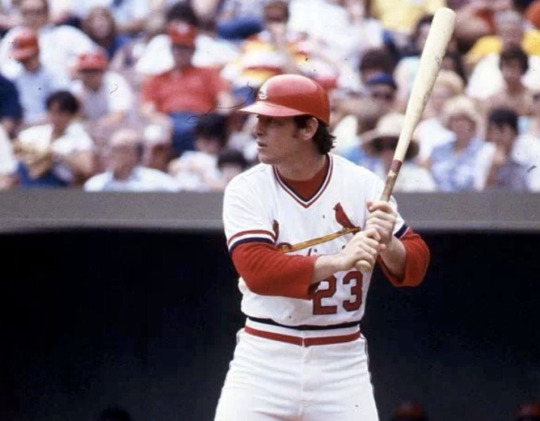
Should the top 10 players at every position be in the Hall of Fame? I think so. As it stands now, Simmons is 10th in all-time JAWS as a catcher and is the only one (other than Joe Mauer, who retired in 2018) who isn’t currently enshrined. If we go around every position’s top 10 non-enshrined he’s in a pretty elite company with Bobby Grich (2B), Scott Rolen (3B), Bill Dahlen (SS), Barry Bonds (LF), Pete Rose (LF), Manny Ramirez (LF), Kenny Lofton (CF), Larry Walker (RF), Roger Clemens (SP), six relief pitchers I don’t care about and non-eligible superstars like Mauer, Albert Pujols, Robinson Cano, Adrian Beltre, Alex Rodriguez and Mike Trout. It seems pretty clear to me that Simmons should be in the Hall.
He was the best player on the Cardinals in 1972, 1973, 1975, 1976, 1977 and 1978 and was the best overall player there during his (1968-1980) tenure. He was also the best catcher in the National League in 1973 and 1977. And he was the best in baseball in 1978. And over his entire career (1968-1988), he was second best overall to Johnny Bench - the greatest catcher of all time - who’s own career (1967-1983) was occurring at the exact same time as Simmons’.
Maybe he’s a victim of bad timing. Simmons’ contemporaries, besides Bench, include Gary Carter (2nd all-time) and Carlton Fisk (4th). But as Jay Jaffe has pointed out, there were 5 active Hall of Fame catchers in 1929 and every year from 1931-1937. So the fact that 4 Hall of Fame catchers would have played between 1974-1983 would not be weird at all. And we’ll talk about a 5th, Thurman Munson (1969-1979), in just a second.
Simmons’ bad timing also included a playoff drought for St. Louis. Which probably had more to do with trading Steve Carlton than the play of Simmons. I would say he had 4 elite seasons while he was in St. Louis. He has similar career stats to Alan Trammel, Joe Torre, Carlton Fisk, Gary Carter, Barry Larkin, Joe Cronin and Yogi Berra. And the top 10 in similarity scores are rounded out by Lou Whitaker (who I heavily insinuated should be in the Hall a moment earlier) and Miguel Tejada.
There have been a lot of theories as to why Simmons still isn’t in Cooperstown. There were contract disputes. There was the fact that he was against the Vietnam War and against Nixon. He was seen as a bad defensive catcher, although current metrics show that to be way overblown. He butted heads with Whitey Herzog, who also wound up as a Veteran’s Committee voter. Which would be even more bad timing. But I think Simmons has mainly been vindicated on all of those things over time. And the timing should finally be right for his induction.
Thurman Munson

His career was cut short after a tragic Cessna crash in 1979. Otherwise, who knows? Munson was the best player on the Yankees in 1973 and 1975. And the best overall from 1969-1979. He was the best catcher in the American League in 1970, 1975 and 1976 and the best in baseball in 1973. His 11-year career also includes a Rookie of the Year Award, two World Series rings and an MVP Award in 1976. The Yankees also made him the team’s first captain since Lou Gehrig. And after his death, the Yankees immediately retired his number and never replaced his locker at old Yankee Stadium.
A short career makes for some sub-par Hall of Fame numbers. And nobody with similar career stats is enshrined in Cooperstown. And that 1976 MVP was a bit of a stretch, even though he was 10th in the AL in fWAR. I would have given him a top 5 finish in 1973, when he finished 12th, but what are you gonna do?
Even with Munson’s untimely death, he’s still 13th all-time on JAWS for catchers. And he’s 8th in peak (WAR7) for catchers, above average for a Hall of Fame catcher and tied with Buster Posey. Which is extra fun since Munson and Posey both won a Rookie of the Year, an MVP, a Gold Glove, a World Series title, and a College Baseball All-American nod. And they’re the only catchers to do all that.
It might be hard to say yes to Munson without putting Ted Simmons in first. Simmons is two spots higher on JAWS. And over Munson’s career (1969-1979), he’s third in fWAR after Johnny Bench and Simmons. But that peak is still better than Simmons’. And Munson still hit .357 in the postseason. Including a 9-for-17 outburst in a losing effort against Bench and the “Big Red Machine” in 1976. I mean, a Yankees team that won back-to-back titles considered Munson their heart and soul. And they had Catfish Hunter, Goose Gossage, Reggie Jackson and some pretty good years around that time from Willie Randolph, Graig Nettles and Ron Guidry. I could honestly go either way. So why not? But Simmons probably needs to go in first.
Don Mattingly
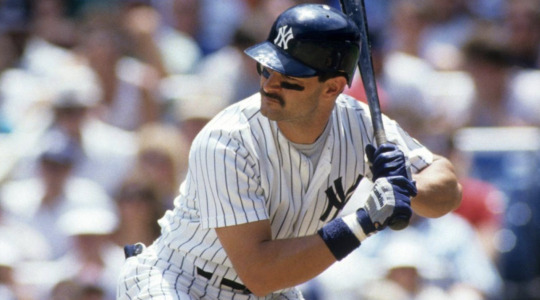
Two of my closest friends consider Mattingly their favorite player of all time. And he’s in one of the greatest "Simpsons" episodes of all time. Oh, and unbeknownst to the writers, he was benched for refusing to trim his mullet in 1991. So there’s that too. But let’s talk about his career.
Donnie Baseball was the face of the New York Yankees when the Yankees were in the longest postseason drought in their post-Babe-Ruth history. They were in the World Series the year before he joined the team. They won the World Series the year after he retired. You could argue that they would have won it all in the strike-shortened season in 1994. But as it stands, Mattingly’s only postseason with the Yankees was that 1995 ALDS against the Seattle Mariners that ended in the bottom of the 11th with a walk-off double (ahem, THE Double) by Edgar Martinez and an elated Ken Griffey Jr. at the bottom of a doggy pile. Mattingly is considered the greatest Yankee to never play in a World Series with the team (probably Rickey Henderson only played 5 seasons in the Bronx) and he’s the only Yankee to have his number retired by the team, without winning at least one ring (Your move, Aaron Judge).
It definitely wasn’t his fault.
Mattingly was the best player on the Yankees in 1984, 1986 and 1987. Henderson was better in ’85, even though that’s somehow the year Mattingly won his MVP (I’d would have given him 4th, after George Brett, Henderson and Wade Boggs). Mattingly SHOULD have won an AL MVP in 1984. And there’s a really good argument for Mattingly winning it in 1986, even though the bozo writers gave it to Roger Clemens (Pitchers have their own awards, guys! And Boggs was on the same team! How are you so stupid???).
Mattingly was also the best American League first baseman from 1984-1987. And probably the best in baseball at first in ’85 and ’86. During Mattingly’s own career (82-95), Eddie Murray was better. And Mark McGwire played in more All-Star Games. But I already know what you’re gonna say about that. Pat yourself on the back for your moral superiority.
Mattingly won 9 Gold Gloves. He was the A.L. MVP in 1985. He won a batting title in 1984. And then he got into a clubhouse wrestling match with Bob Shirley in 1987, injured his back, and wasn’t really the same after that. I guess, it was the same year as Hogan-Andre at WrestleMania III and wrestling was pretty big at the time, but yeah. The Yankees promptly released Shirley, by the way. Mattingly would have moments where he looked like his old self. He was still great, defensively. But the back problems persisted. And Mattingly ended his career after only 14 seasons, when he was 34-years-old.
Mattingly is ranked on JAWS as the 40th-best first baseman of all time. That’s behind first basemen like Rafael Palmeiro, Todd Helton, McGwire, Keith Hernandez, John Olerud, Will Clark, Fred McGriff, Norm Cash, Dolph Camilli, Gil Hodges, and Carlos Delgado. That’s also behind not-yet-eligible first basemen like Albert Pujols, Miguel Cabrera, Joey Votto, Jason Giambi, David Ortiz, Mark Teixeira, and Paul Goldschmidt. He has 222 career home runs, 2,153 hits, and a .307 career average. Of the 10 most-similar batters, only Kirby Puckett is in the Hall of Fame. He would be well below average for a Hall of Fame first baseman. Better than Mark Grace. About half as good as Frank Thomas.
Should Mattingly be in the Hall of Fame? No. Then again, he was better than Harold Baines, so what do I fucking know? But Mattingly spent 15 years on the writers’ ballot. He never got higher than 28.2% of the vote (his first year). His final season only garnered 9.1%. His peak wasn’t high enough. His career wasn’t long enough. And he definitely shouldn’t have played grab ass with Bob Shirley in 1987. The sideburns, however, can stay.
Dave Parker

They called him “The Cobra”, he used a sledgehammer in the on-deck circle, he wore a Padres helmet AND a Reds helmet in the 1977 All-Star Game… while he was on the Pirates, and he loved cocaine. Boy did he ever, apparently. He was also the best player on the Pirates in 1975, 1977, 1978 and 1979. And then he was the best player on his hometown Reds in 1984 and 1985. I’d also say he was the best right fielder in baseball in ’75, ’77, ’78 and the best in the N.L in ’85. Parker was a seven-time All-Star, he won two batting titles, three Gold Gloves, two World Series rings and received MVP votes in nine different seasons, including winning one in 1978. He was baseball’s first million dollar contract. I think he had five elite seasons. He deserved that ’78 MVP. And I would have given him 2nd in 1975 (he got 3rd), 4th in 1977 (3rd again), 6th in 1979 (10th) and 5th in 1985 (he got 2nd). Parker also got 5th place in 1986, which is stupid. Dude had a 0.7 fWAR, but he also had 116 RBI and you know how stupid these guys were with the RBI.
It’s possible the cocaine got the best of him. Or the injuries. Or the weight gain. Because it looked like he was well on his way to a Hall of Fame career in the late 70’s, and except for a brief bump (sorry) in 1985, he didn’t do much else after 1979. That leaves Parker as the 5th-best right fielder, even in his own exact timeframe in the Majors (1973-1991, after Dwight Evans, Dave Winfield, Andre Dawson and Reggie Jackson). He would be well below average for a Hall of Fame right fielder. JAWS ranks him as the 39th-best right fielder of all time. That’s behind Larry Walker, Shoeless Joe Jackson, Evans, Reggie Smith, Sammy Sosa, Bobby Bonds, Gary Sheffield, Brian Giles, Jack Clark, Tony Oliva, Rocky Colavito, and Rusty Staub. He’s also behind not-yet-eligible players like Ichiro Suzuki, Bobby Abreu, and Mookie Betts. He was better than Darryl Strawberry. Miles behind Tony Gwynn.
With over 2,700 hits and 339 home runs in 19 seasons, Parker does have similar career stats to Tony Perez, Billy Williams, Harold Baines and Andre Dawson. Not quite inner-circle guys. And Parker never got more than 24% of the vote from the writers. And I think he’s relegated to the Hall of Very Good. But he’s not a Hall of Famer.
Steve Garvey

They called him Mr. Clean, even though he totally wasn’t. He has some, uh, ugly relationships with women. A weird fact that dashed all of his hopes to become a Republican Congressman later in life. I think a lot of Garvey’s popularity and fame during his career had to do with his looks. He was never the best player on the Dodgers. And during his tenure there (1969-1982), he was second to Ron Cey in overall fWAR. And while he was the best first baseman in the National League in 1975, 1976 and 1978, he was only 7th-best over the 15 years he played first base (1973-1987) after Keith Hernandez, Darrell Evans, Rod Carew, Eddue Murray, Gene Tenace and Pete Rose. JAWS ranks him as the 51st-greatest first baseman of all time, behind too many non-Hall players than I care to type. His career numbers are similar to Orlando Cepeda (#33), but they look more like those of John Olerud (#22), Will Clark (#26) and Mark Grace (#41). Even though all of those players were better.
It was the FAME part of the equation that Garvey seemed to have down. He was a 10 time All-Star. He remained a part of a Dodgers infield with Ron Cey, Bill Russell and Davey Lopes for 8.5 years. He played in 1,207 consecutive games (1975-1983), which is the 4th-longest streak ever. He won a ring with the Dodgers in 1981 and was a two-time NLCS MVP. And in 1974, he won an NL MVP while only finishing 20th in the League in WAR. And he got really close again in 1978. But he didn’t really deserve to be in that conversation either. Of all the player’s on this year’s ballot, Garvey is the weakest candidate.
1 note
·
View note